Jim has been a fearless New Left editor, a political performance artist, part of a guerrilla theater troupe, and has worked with some of the legendary figures of the ’60s.
Last summer political scientist Bob Sharlet attended a reunion in Bloomington, Indiana, of New Left activists who had gone to school at Indiana University in the 1960s and early ‘70s. They came to the event from all over the country. “Quite a number had not broken bread or lifted a glass together in at least a quarter of a century,” Bob noted, “while many had neither met nor even spoken for over 50 years.”
Sharlet interviewed several of those in attendance for his blog, Searching for Jeff, which is dedicated to his late brother, Jeff Sharlet, who was a leader of the GI resistance movement during the Vietnam War and also was active in SDS at Indiana in the mid-‘60s. (And who shouldn’t be confused with the award-winning journalist and author of the same name. That Jeff Sharlet is Bob Sharlett’s son.)
Sharlet’s final interview was with Austin resident and Rag Blog designer and contributing editor, Jim Retherford, who has been our friend and colleague dating back to his days in Bloomington when he was editing the underground paper, The Spectator and we were publishing The Rag in Austin. Here is Bob Sharlet’s profile of the “Man in a Red Devil Suit.”
One remarkable profile remains as we reach the end of this series on the Indiana University (IU) New Left reunion, summer 2013.† Jim Retherford has had an extraordinarily noteworthy and diverse career on the left from his early years at IU to present day.
He has been a fearless New Left editor, a political performance artist, part of a guerrilla theater troupe, and along the way got acquainted with some of the legendary figures of the unforgettable ‘60s/early ‘70s. Running through the years of his rich resume, one sees he also has been an award-winning journalist and graphic designer — a veritable man of the left “for all seasons.”
Jim Retherford arrived at IU in ’60 with good student journalist credentials, but as a typical politically naïve freshman. Campus events soon politicized him.
He got off to a good start as a college journalist, landing a position on the staff of the campus daily, the Indiana Daily Student (IDS), his first semester and by spring becoming the paper’s sports editor.
Then he inadvertently witnessed an early IU New Left action and came away politicized. A tiny group of students, the Fair Play for Cuba Committee (FPCC) protesting the U.S. naval blockade of Cuba during the Missile Crisis of fall ’62, were jeered, harassed, and threatened by a crowd of several thousand hostile students. Jim came away shocked and a lifelong supporter of the Cuban Revolution.
As an activist, Jim leaned toward dramatic action in matters political.
As an activist, Jim leaned toward dramatic action in matters political. A few years after, Students for a Democratic Society (SDS) was organized at IU, and Jim joined up. The group, opposed to the Vietnam War, had adopted a policy of open meetings, open mike. On one occasion a conservative student leader took advantage and filibustered a meeting with a pro-war rant.
Other than shouts to end the harangue, the group sat passively, reluctant to violate SDS’s policy of openness. Jim Retherford was not having it, so he and a fellow activist took a large American flag off the pole in the corner, “wrapped” the speaker in the flag, and duck-walked him off stage to much laughter and relief.
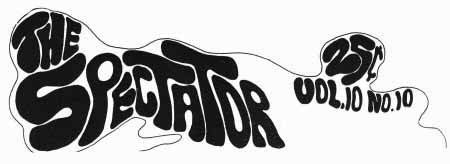
Retherford edited The Spectator, a lively political-cultural alternative publication in Bloomington.
The following year, 1966, several students created an alternative “underground” campus paper, The Spectator, and several months later Jim became the editor. The experience would take him beyond political awareness and radicalize him.
A lively political-cultural alternative to IDS, The Spectator drew on Underground Press Syndicate and Liberation News Service (Jim worked with Marshall Bloom, the founder) — both New Left news services — for stories ignored by the mainstream media. Under Jim’s aegis, the paper became increasingly critical of IU’s administration and trustees as well as the local political establishment.
The Spectator gave ample coverage to the spirited IU New Left, of which the university president was highly critical. When my brother Jeff Sharlet, then SDS president, rebutted the criticism in a major speech, Jim promptly published the full text. ††
The paper afforded great visibility to the major demos against the campus visits of Army General Maxwell Taylor; General Lewis Hershey, director of the Selective Service System; Secretary of State Dean Rusk; as well as to the sit-in blocking Dow Chemical recruiters at the Business School.
In the midst of all the protest, Jim Retherford was summoned by his draft board.
In the midst of all the protest, Jim Retherford was summoned by his draft board. He turned up at the induction center wearing Viet Cong-style black pajamas and rubber sandals and handed out antiwar leaflets to the inductees. The feds weren’t amused and responded with an over-the-top threefold indictment against him for trivial technical violations of the Selective Service law, including one for not carrying his draft card (he had two, thanks to an error by the local draft board).
Simultaneously, the university authorities, who had become quite irritated with The Spectator’s criticism of their policies, moved to silence Jim and the irreverent paper. The Spectator staff was ordered to vacate its campus premises. Impatient, the dean of faculty, a former CIA Far East station chief, decided to expedite the eviction. With a fire axe in hand, he broke down the door, destroyed equipment, and scattered files in the snow.
Undeterred, Jim moved the paper off campus to what he called a “liberated zone” and continued the steady drumbeat of coverage and sharp criticism of IU’s administrators. Street sales of the paper in Bloomington reached 1,000; there were also mail subscriptions as well as orders from bookstores as far away as Boston and San Francisco.
In late spring ’68, Jim Retherford went on trial in federal court. He was convicted and sentenced to six years in prison. His bond revoked, he languished in jail for nearly three months until his conviction was overturned on appeal thanks to a prominent New York lawyer on the left.
Jim left Bloomington, moved to New York, and onto the national stage of the antiwar struggle. Earlier in ’67 he had already played a role as an organizer of the siege of the Pentagon when thousands of protestors from all over the country encircled the immense building in an attempt to “levitate” it.
In New York, Jim soon hooked up with poet, singer, and activist Ed Sanders, co-founder of the Fugs, a well-known psychedelic rock band of the day. He got to know Yippie leader Jerry Rubin, whose book he agreed to ghostwrite. DO IT! Scenarios of the Revolution was published in early ‘70 to much fanfare and a lengthy run on the New York Times bestseller list.
♫ Who can train guerillas by the dozens?
Send them out to kill their untrained cousins?
F**king-a man!
CIA Man!†††
In early ’69, federal conspiracy charges were filed in Chicago against Jerry Rubin, Dave Dellinger, Tom Hayden, and others for their parts in the antiwar demonstrations at the Democratic National Convention. With Rubin and Abbie Hoffman in the lead, the defendants turned the trial into raucous political theater with federal judge Julius Hoffman cast as villain. As Jerry’s friend and ghostwriter, Jim was invited to Chicago to take in the wild courtroom scene.
En route back to New York, he stopped off in Bloomington to visit friends and heard that Clark Kerr, former president of the University of California Berkeley and bête noir of the ’64 Free Speech Movement at Berkeley, would be speaking at IU. By coincidence, Jerry Rubin, former UC Berkeley student and infant terrible of the FSM, was booked to speech at a Vietnam Moratorium event at nearby Dunn Meadow.
Sensing a cosmic convergence, Jim planned a Yippie counter-performance.
Sensing a cosmic convergence, Jim planned a Yippie counter-performance. As Kerr began his remarks, Jim, who’d been hiding in the wings, rushed onstage decked out in a red devil costume and threw a cream pie in the speaker’s face. Hoping to get away, the “red devil” was nonetheless caught, arrested, convicted of disorderly conduct, and sentenced to 90 days in jail. The “pieing” of Clark Kerr made the nation’s papers.
The ‘70s were an eventful time on the East Coast, and Jim Retherford was in the thick of it. In late spring ’70, he went to New Haven, Connecticut, with the band Elephant’s Memory, an experimental rock group better known as backup for John Lennon and Yoko Ono’s Plastic Ono Elephant’s Memory Band. The band performed at a huge May Day demo on the green across from the Yale campus as thousands protested the trial of Bobby Seale and the New Haven Black Panthers.
♫ Hey little chile don’t you put me on trial
You got me burnin’ on a fiery pile††††
That summer, Jim joined Abbie Hoffman for a Yippie happening at Madison Square Garden in New York. Taking on the popular band Blood Sweat and Tears, just back from a tour of Communist East Europe covertly underwritten by the CIA, Hoffman and his troupe dumped 50 pounds of cow manure and passed out leaflets mocking the band as Blood Sweat and Bullshit at the garden’s entrance just as the crowd was arriving for the concert.
The following year a New York federal grand jury subpoenaed Retherford and fellow Yippies, “fishing” for information about a bombing in Washington with which the five had no connection. Calling themselves the “Ever-Expanding Number,” the Yippie group duly appeared at the federal building with Jim sporting a King Kong outfit. If they were looking for antiwar guerrillas he figured, why not dress like a real gorilla.
Finally, election night 1972 found Jim Retherford walking the streets of Manhattan in the company of John Lennon and friends. Headed to Jerry Rubin’s election watch party carrying armloads of tequila, the group happened by a major New York bank branch office on a dark corner and “spontaneously” came up with the idea of “trashing” the windows. The tequila bottles they tossed shattered, but the bank windows survived.
Later in the decade, Jim left New York and relocated to Texas.
Later in the decade, Jim left New York and relocated to Texas — first Houston, then Austin — where he raised his young son Jesse James. He eventually joined the staff at the University of Texas-Austin.
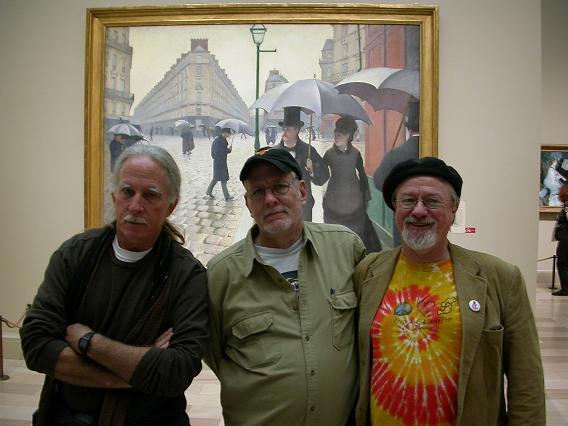
Tres Amigos: Jim Retherford, far right, with, from left, Austin activist David Hamilton and Rag Blog editor Thorne Dreyer. Photo taken at the Chicago Art Institute, November 2007.
Fast forward to the present, Jim Retherford retired several years ago as senior graphics designer, General Libraries, University of Texas at Austin. However as a long time Austinite, he continues to take part in the city’s progressive politics.
At IU last summer, Jim, the final speaker, rose to talk about his life at the New Left gathering, but time was short on the kick-off event, and he only had a chance to sketch a few of his adventures. Let’s listen to him in his own voice:
Hi, I’m Jim Retherford, and what a long, strange trip it’s been. I came to Bloomington a farm boy from north central Indiana, 1960. I was skinny then. I kind of left Bloomington in the summer of ’68, although I had a tendency to come back and create some diversions for everybody.
In October ’69 when Clark Kerr began his lecture series at IU on how he had figured out [how to coopt with the the student protest movement], I decided to practice a little reverse Marxian repressive power … and he ended up getting a pie in the face.
I came here as a journalism student and spent two and a half years in the Journalism Department. I left the department very angry at the chairman for lying to me about stuff. It was during that time that I became politicized…. The Fair Play for Cuba march [October ‘62] started a number of things going.
One, it started in me a long-term quest that continues today – to understand and appreciate the revolution in Cuba and what it accomplished. That was just the beginning.
The other thing that it created — a strain that has continued — was when I was in the city room of the Indiana Daily Student (IDS) right after the Fair Play march when two guys in trench coats, whom I recognized from pictures taken at the march, came into the room and introduced themselves as graduate students. [laughter]
They asked if me and my friend, who was the IDS chief editorial writer at the time, if we had known anything about those guys [the pro-Cuba marchers]. I was only a sophomore at the time, but I knew this was bullshit. That was the beginning of my distrust of the intelligence apparatus.
In ’66 a group of graduate students — by then I was in the English Department — started talking about forming an alternative newspaper. I attended all their meetings and helped launch the new paper [The Spectator], but as an undergrad among mostly grad students, I didn’t really have great rapport with the other organizers. There wasn’t good chemistry, so I just helped on the journalistic part of the paper — telling them how to lay it out and stuff, but I didn’t get really active in it.
The grad students mostly flunked out of school and a Spectator staff came together that following September. There was somebody who the Dean of Students wanted to be the editor, but nobody wanted her so they talked me into doing it. I edited The Spectator for the next two years.
That was a radicalizing experience. From the very beginning I made space in The Spectator for all points of view, but when Robert Turner* [a conservative student leader] took advantage of it, we kind of got rid of that policy because it was redundant to say the same thing over and over again. We’d heard enough of that.
During this period of time, I became more questioning and more radical and it ended up that I was moving up the FBI watch list, as I found out later. In ’67 just 11 days before my 26th birthday, which would have freed me from all my draft-duty obligations, I woke up one morning to discover two federal indictments for Selective Service violations, both bogus, non-existent. I wasn’t even a [draft] delinquent.
Then in January, a third indictment was added. I went to trial in May ’68. I was convicted and sentenced to six years in prison. My appeal bond was revoked as they [the feds] tried to block my right of appeal. I ended up in jail for almost three months waiting for all that to shake out.
I moved to New York to be near my lawyer, Leonard Boudin.** I got involved in the movement in New York, spent seven or eight years there. I worked with Jerry Rubin. I conceptualized and ghostwrote his book [DO IT! (1970)]. I was tied in with the Yippies, did a bunch of stuff with the artist’s movement, and worked with the Young Lords Organization*** to take over a rock-and-roll festival in New York and score $20,000 for the People’s Community Clinic in the South Bronx.
I was [also] involved with a bunch of people who did some crazy things, and I ended up doing a lot of defense committee work. Those of you who’ve done that know how depressing and debilitating it is. It kind of sucks the life out of you; you’re doing this instead of the stuff you need to and want to be doing. You’re on the defensive…
In Austin now I am on the Board of Directors of the New Journalism Project. I’m one of the people working on a project called The Rag Blog, which is a digital outgrowth of The Rag, one of the first underground papers in the country [during the ‘60s].**** We also run a weekly radio program [Rag Radio], and we do a lot of outreach things. That’s basically what I’m doing now and why I’m here.
Long a premier journalist with prizes to his credit, Jim Retherford continues to publish. In 2004 The New York Times ran his op-ed, and, since its inception in ’06, several of his essays have appeared in The Rag Blog, a weekly online journal of the left edited by Thorne Dreyer in Austin, Texas.
A modest individual, Jim Retherford has compiled an amazing curriculum vitae of a lifetime on the left. This brings to a close Lives of the New Left, a series responsive to the historical question, What became of the Indiana New Left?
The essays in response, framed in the lives of the individuals profiled, are also meant to reflect the generation of ‘60s activists writ large of whom the IU group was an integral part.
† There were additional speakers at the reunion assembly, but only the recordings of the remarks by the 15 individuals profiled in Lives of the New Left I-VI, were sufficiently audible.
†† For an account of Jeff Sharlet’s public exchange with the IU president, see, http://jeffsharletandvietnamgi.blogspot.com/2011/08/elvis-and-new-left-at-indiana.html
Links to music videos:
††† http://www.youtube.com/watch?v=hW9cCWm53H4
†††† http://www.youtube.com/watch?v=rjx9wUCHC4U
*Robert F Turner, as an IU undergrad, was president of the IU Conservative League, which brought various conservative speakers to campus and distributed literature. Later, Turner focused on the Vietnam War as national research director and Indiana State Chairman of the Student Committee for Victory in Vietnam. Following graduation he was commissioned an Army officer and served two tours in Vietnam. Professor Turner is currently Associate Director of the Center for National Security Law at University of Virginia Law School. See http://jeffsharletandvietnamgi.blogspot.com/2013/07/blueprint-fr-police-state-in-american.html.
**The late civil liberties lawyer and left-wing activist Leonard Boudin was involved in the defense of the Bloomington Three (B-3) after their arrest following the IU demonstration protesting President Kennedy’s naval blockade of Cuba during the Missile Crisis of October ’62. Known for his representation of high profile anti-Vietnam War defendants such as Daniel Ellsberg and Dr Benjamin Spock, Boudin also served as defense counsel for less well-known individuals and organizations. On the case of the B-3, see the profile of Paulann Hosler Sheets in http://jeffsharletandvietnamgi.blogspot.com/2013/11/activist-legacies-in-hoosierland-lives.html.
***The Young Lords were a Puerto Rican organization that evolved from a Chicago street gang as a result of Mayor Daley’s political machine’s ‘urban renewal’ program during the ‘60s. When an entire Puerto Rican neighborhood was evicted in favor of up-market real estate development, the Young Lords confronted the machine in the Division Street Riots of 1966. In ’68 the Young Lords reorganized as a human rights movement and spread to cities across the country. They quickly achieved national prominence for mobilizing thousands of people in similar neighborhood actions in other places. The organization continues to exist to this day in the struggle for Puerto Rican rights and independence.
****The Rag was a legendary alternative newspaper in Austin TX, a major center of the counterculture of the ‘60s. The paper covered radical politics, the war in Vietnam, civil rights struggles, the student freedom movement, women’s liberation movement, and local protest politics as well as national and world news from the Liberation News Service. Closely associated with the SDS chapter at University of Texas-Austin, The Rag featured articles by national SDS and other New Left leaders. From a reunion of former staffers, The Rag Blog was founded in 2006; see https://www.theragblog.com/. An online news magazine, it features much of the same content as its predecessor and is edited by Thorne Dreyer, one of the original Rag editors, who also hosts Rag Radio. This post has benefited from his Rag Radio interview with Jim Retherford in 2010; see https://archive.org/details/RagRadio02-23-2010.
A version of this article appeared at Searching for Jeff.
Read articles by James Retherford on The Rag Blog and listen to Thorne Dreyer’s Rag Radio interview with Jim.
[Robert Sharlet is the retired Chauncey Winters research professor of political science at Union College, a small independent liberal arts college founded in 1795 in Schenectady, New York. Bob’s brother Jeff Sharlet was founder of Vietnam GI, the pioneering anti-war publication written and produced by Vietnam veterans, and, before that, an important activist in the early days of SDS in Bloomington, Indiana. Bob’s son, also named Jeff, is a nationally recognized journalist, author of The Family: The Secret Fundamentalism at the Heart of American Power, and the 2011 recipient of The Texas Observer‘s MOLLY National Journalism Prize.]

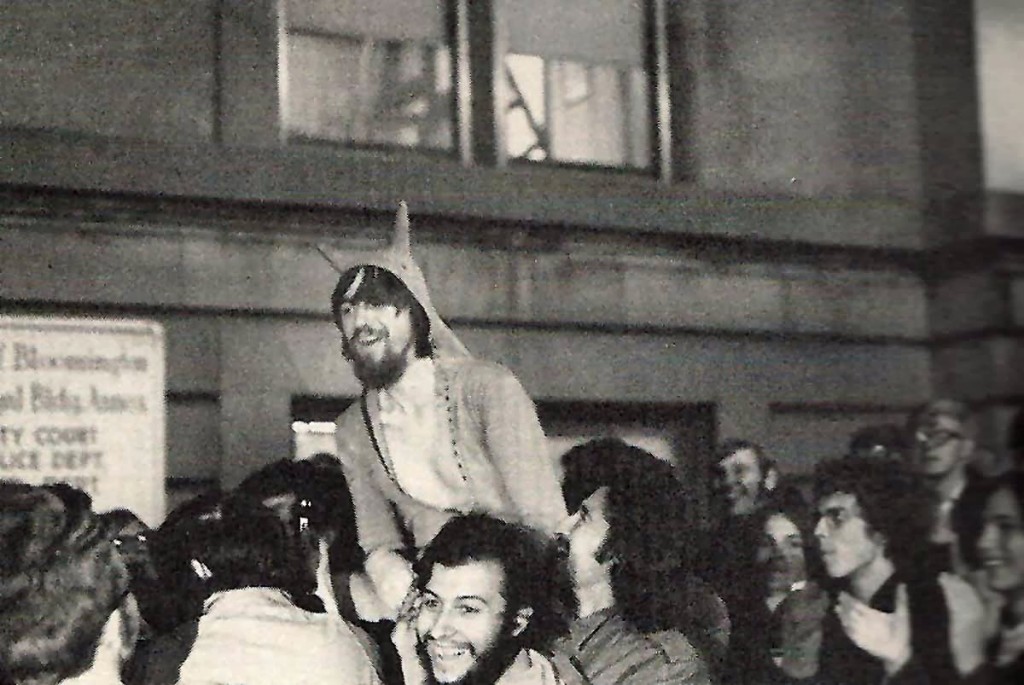
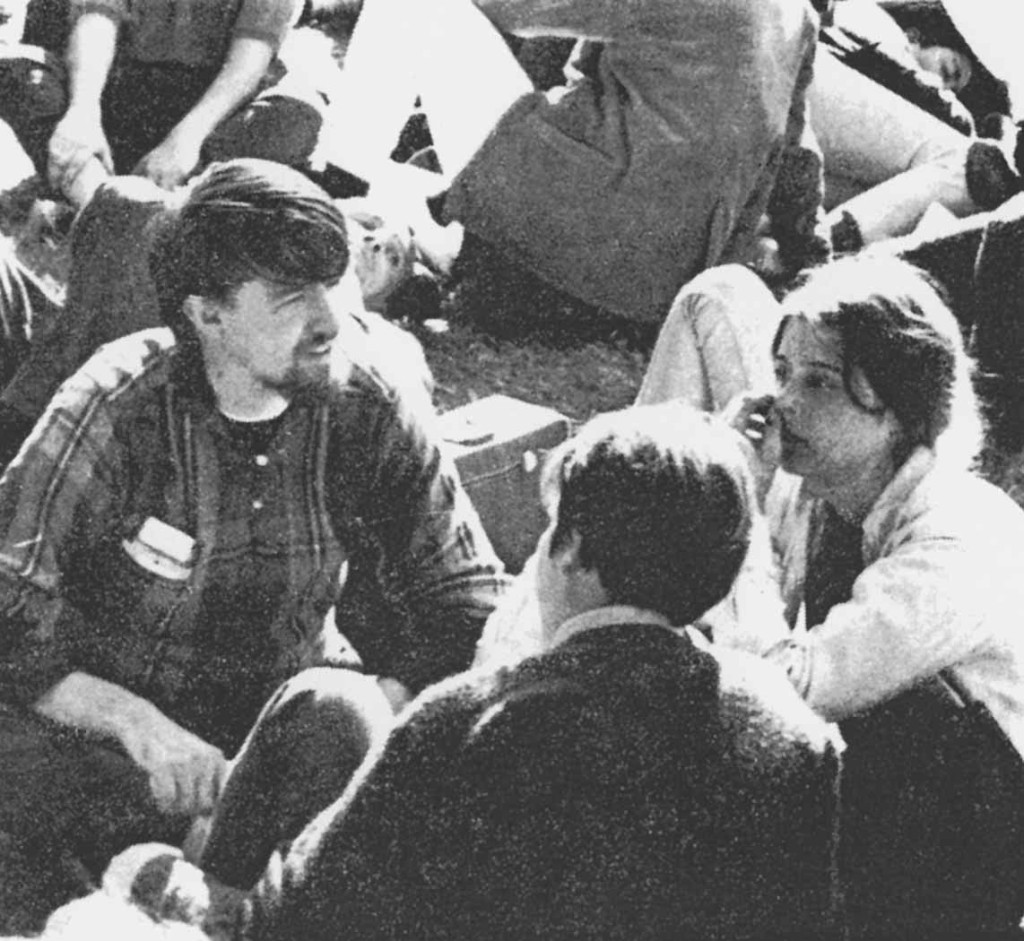
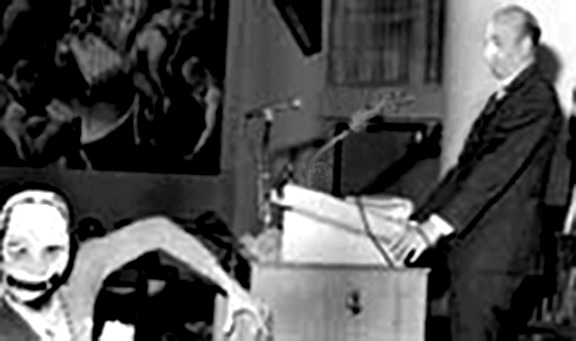
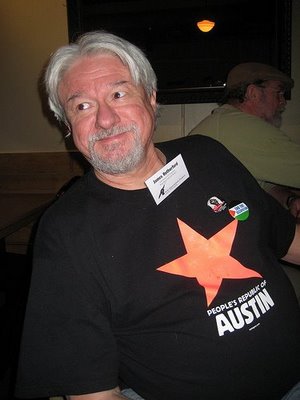

















Hee hee — this is great fun! For those of us who knew Jim only fleetingly in the “good old days” but for whom he’s become an integral part of the community, it’s good to know the stuff about him we know about those who spent the whole of the 60s and 70s in Austin!
Oh wow — this is kewl!! A newly discovered benefit of the new Rag Blog site — no longer having to read those weird little signs and numbers every time I want to post a comment! Three cheers, whoever worked THAT out!
My sentiments exackly, Mariann.
This is so delightful; I love all our reminiscences of 5 decades ago. May we all learn from them. I know Jim, but not well–wow, does he have a great history! I certainly did not know he was the guy who pied Clark Kerr (I was a student at a U.Calif campus; we loved it!).
“[A] long-term quest that continues today”; yeah, let’s keep on moving forward, folks. Thanks, Bob & Jim.
Was in grad school at IU ’65-’70. Went to the Clark Kerr lecture with my friend Gray Sweeney, saw Jim get Kerr with the pie. That pretty much emptied the lecture hall, so we went to Dunn Meadow, where Rubin got people fired up, and we (several hundred?) marched off campus, down Kirkwood to the police station, and blocked Walnut (until one trucker didn’t slow down). Most truckers gave the fist up union sign, only a couple tossed us the finger. Emptied our pockets, getting up bail for Jim. After an hour (two?), the red tape was cut inside and Jim emerged to great cheers. Great to see the pic of Kerr and especially the one of Jim being lifted by the crowd. Takes me right back and I can still hear it all faintly in my left ear. A good devilish night and still a strong memory.